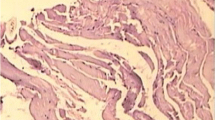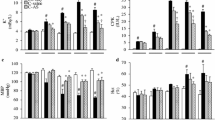Abstract
The present study aims to explore whether Mg infusion has a preventive effect on ischemia–reperfusion injury in rats. A total of 20 Sprague-Dawley-type adult male rats were used. In group 1 (control), 0.9% isotonic solution was administered. In group 2 (experiment), magnesium sulfate (0.5 mg per 100 g) was administered. Ischemia was induced for 15 min for the two groups. Magnesium (Mg), interleukin 8 (IL-8), and malondialdehyde levels were analyzed in blood, while edema, neutrophil infiltration, eosinophilia, loss of striation, and nucleolization were evaluated in histopathological examination. Mg levels in the experiment group were higher than those in the control group after ischemia–reperfusion (p < 0.05). In the control group, postischemia and postreperfusion IL-8 values were higher than preoperative values (p < 0.05). As for eosinophilia and loss of striation values, these were higher in the experiment group after ischemia–reperfusion than the values in the control group (p < 0.05). Histopathologically, Mg infusion cannot prevent the tissue injury triggered in ischemia–reperfusion periods. Eosinophilia can be one of the major and earliest markers of ischemia–reperfusion injury.


Similar content being viewed by others
References
Aktan AO, Yalçın AS (1998) Ischemia–reperfusion injury, reactive oxygen metabolites, and the surgeon. Turk J Med Sci 28:1–5
Akcil E, Tug T, Doseyen Z (2000) Antioxidant enzyme activities and trace element concentrations in ischemia reperfusion. Biol Trace Elem Res 76:13–17
Hori M, Gotoh K, Kitakaze M, Iwai K, Iwakura K, Sato H, Koretsune Y, Inoue M, Kitabatake A, Kamada T (1991) Role of oxygen-derived free radicals in myocardial edema and ischemia in coronary microvascular embolization. Circulation 84:828–840
Belkin M, Brown RD, Wright JG (1988) A new quantitative spectrophotometric assay of ischemia–reperfusion injury in skeletal muscle. Am J Surg 156:83–86
Steinau HU (1988) Major limb replantation and postischemia syndrome: investigation of acute ischemia-induced myopathy and reperfusion injury, vol. 11. Springer, New York, pp 9–33
Sabido F, Milazzo VJ, Hobson RW, Duran WN (1994) Skeletal muscle ischemia–reperfusion injury: a review of endothelial cell–leukocyte interactions. J Invest Surg 7:39–47
Labbe R, Lindsay T, Walker PM (1987) The extent and distribution of skeletal muscle necrosis after graded periods of complete ischemia. J Vasc Surg 6:152–157
Petrasek PF, Homer-Vanniasinkam S, Walker PM (1994) Determinants of ischemic injury to skeletal muscle. J Vasc Surg 19:623–631
Lu YT, Hellewell PG, Evans TW (1997) Ischemia–reperfusion lung injury: contributions of neutrophils and hydrostatic pressure. Am J Physiol 273:46–54
Moens AL, Claeys MJ, Timmermans JP, Vrints CJ (2005) Myocardial ischemia reperfusion-injury, a clinical view on a complex pathophysiological process. Int J Cardiol 100:179–190
Mc Lean RM (1994) Magnesium and its therapeutic uses: a review. Am J Med 96:63–76
Kharb S, Singh V (2000) Magnesium deficiency potentiates free radical production associated with myocardial infarction. J Assoc Phys India 48:484–485
Akkus I (1995) Serbest radikaller ve fizyopatolojik etkileri. Mimoza, Konya, pp 36–37
Christensen CW, Rieder M, Silverstein EL, Gencheff NF (1995) Magnesium sulphate reduces myocardial infarct size after coronary reperfusion in a canine model. Circulation 92:2617–2621
Besogul Y, Tunerir B, Ozdemir C, Aslan R (2003) Magnesium-flush infusion into the aortic root just before reperfusion reduces the requirement for internal defibrillation and early post perfusion arrhythmias. J Int Med Res 31:202–209
Braunwald E, Kloner RA (1985) Myocardial reperfusion: a double-edged sword? J Clin Invest 76:1713–1719
Wasowicz M, Sobczynski P, Biczysko W, Szulc R (1999) Ultrastructural changes in the lung alveoli after cardiac surgical operations with the use of cardiopulmonary bypass. Pol J Pathol 50:189–196
Kiss K, Stuhlinger HG, Glogar HD, Smetana R (2000) Magnesium in coronary artery disease—is there evidence? Wien Med Wochenshr 150:325–329
Gumina RJ, Jahangir A, Gross GJ, Terzic A (2000) Cardioprotection: emerging pharmacotherapy. Expert Opin Pharmacother 2:739–752
Shen AC, Jennings RB (1972) Kinetics of calcium accumulation in acute myocardial ischemic injury. Am J Pathol 67:441–452
Oe H, Kuzuya T, Hoshida S, Nishida M, Hori M, Kamada T, Tada M (1994) Calcium overload and cardiac myocyte cell damage induced by arachidonate lipoxygenation. Am J Physiol 267:1396–1402
Rohmann S, Weygandt H, Minck KO (1995) Preischaemic as well as postischemic application of a Na+/H+ exchange inhibitor reduces infarct size in pigs. Cardiovasc Res 30:945–951
Genovese A, Chiariello M, Latte S, de Alfieri W, Cacciapuoti AA, Condorelli M (1980) Effects of antiplatelet and calcium antagonist drugs on infarct size in rats. Acta Cardiol 35:419–427
Toyooka T, Kamishiro T, Fumino H, Masaki T, Hosoda S (1984) Rabbit hearts for the critical evaluation of drugs to reduce the size of experimentally produced acute myocardial infarction. Jpn Heart J 25:623–632
Hoff PT, Tamura Y, Lucchesi BR (1989) Cardioprotective effects of amlodipine in the ischemic-reperfused heart. Am J Cardiol 64:1011–1161
Ely SW, Berne RM (1992) Protective effects of adenosine in myocardial ischemia. Circulation 85:893–904
Herzog WR, Schlossberg MR, Mac Murdey KS, Edenbaum LR (1995) Timing of magnesium therapy affects experimental infarct size. Circulation 92:2622–2626
Juarez U (2001) Magnesium in the treatment of acute myocardial infarction, review and controversies. Arch Cardial Mex 71:335–344
Govda RM, Khan IA (2004) Magnesium in treatment of acute myocardial infarction. Int J Cardiol 96:467–469
Endoh M (2005) Magnesium and cardiovascular regulatory factor. Clin Calcium 15:162–174
Author information
Authors and Affiliations
Corresponding author
Rights and permissions
About this article
Cite this article
Gormus, Z.I., Ergene, N., Toy, H. et al. Preventive Role of Magnesium on Skeletal Muscle Ischemia–Reperfusion Injury—an Experimental Study. Biol Trace Elem Res 127, 183–189 (2009). https://doi.org/10.1007/s12011-008-8228-2
Received:
Accepted:
Published:
Issue Date:
DOI: https://doi.org/10.1007/s12011-008-8228-2




